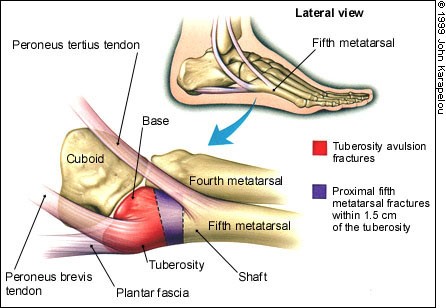What is it?
The metatarsals are a group of 5 long bones in your foot, the 5th is the most affected, and forms the internal part of your little toe. You can feel the base by touching the ‘sticky out bit’ on the outside border of your foot. There are a few attachments with muscles, ligaments and fascia but the most common injury is a fracture; 56% of metatarsal injuries happen at the 5th.
How does it get injured?
5th metatarsal injuries generally happen by a fall from standing height or an ankle twist when the front of the foot stays fixed. The peroneal muscle that attaches can be injured with a sudden, forceful passive ankle dorsiflexion (pulled up) with your foot turned in slightly. An avulsion fracture is when the muscle pulls a small piece of bone off and happens when the ankle is sprained badly; a Jones fracture can an overuse injury or when the foot rolls in while the toes are pointed down; a spiral (or dancer’s fracture) is when you loose balance when on tiptoe and the ankle rolls inwards.
What does it feel like?
Fractures can feel different depending on what part of the bone are affected, and may include pain along the outside of your foot; being unable to bear weight on the affected side; progressive increase to pain that is worse with activity; swelling and bruising; or an unusual bony prominence.
How are they diagnosed?
We can use different skills including feeling along the bone for the tender point, checking range of motion, muscle power and specific tests including balance, calf raises and hop tests. If we suspect a fracture, we can refer you for an X-Ray and immobilisation with a cast/moonboot if required.
What can Back In Action do to help?
The exact cause of your pain needs to be identified, including any reasons that may have made you more susceptible to injury. Depending on the injury type, an X-Ray can be done or referral to an Orthopaedic Specialist if the injury is more complex. When a comprehensive treatment plan has been discussed and organised, and possibly when the fracture has healed enough, a rehabilitation programme would be started. This is likely to include more exercises than manual treatment, for example, foot mobility, strengthening exercises and balance exercises using a wobble board.

